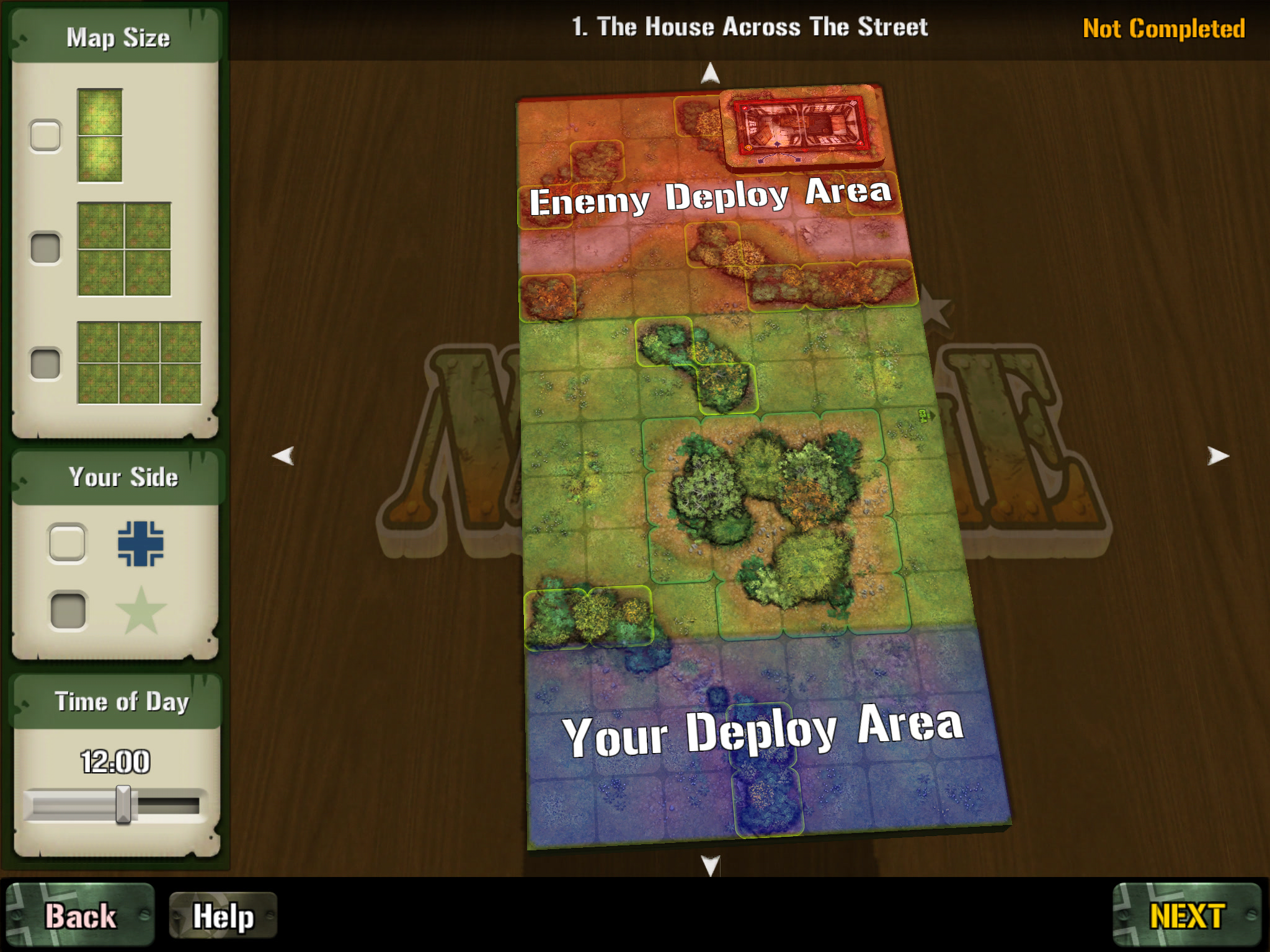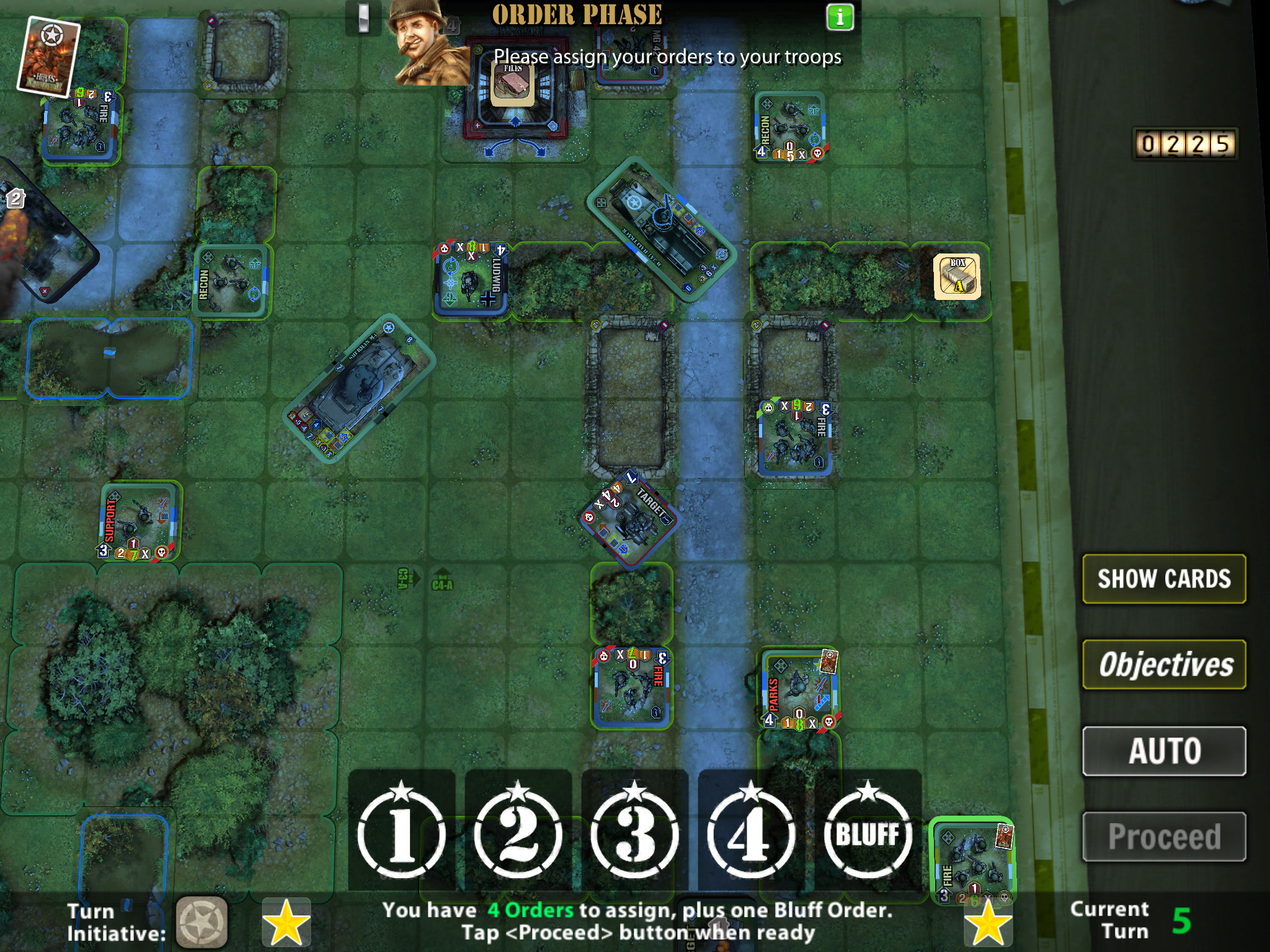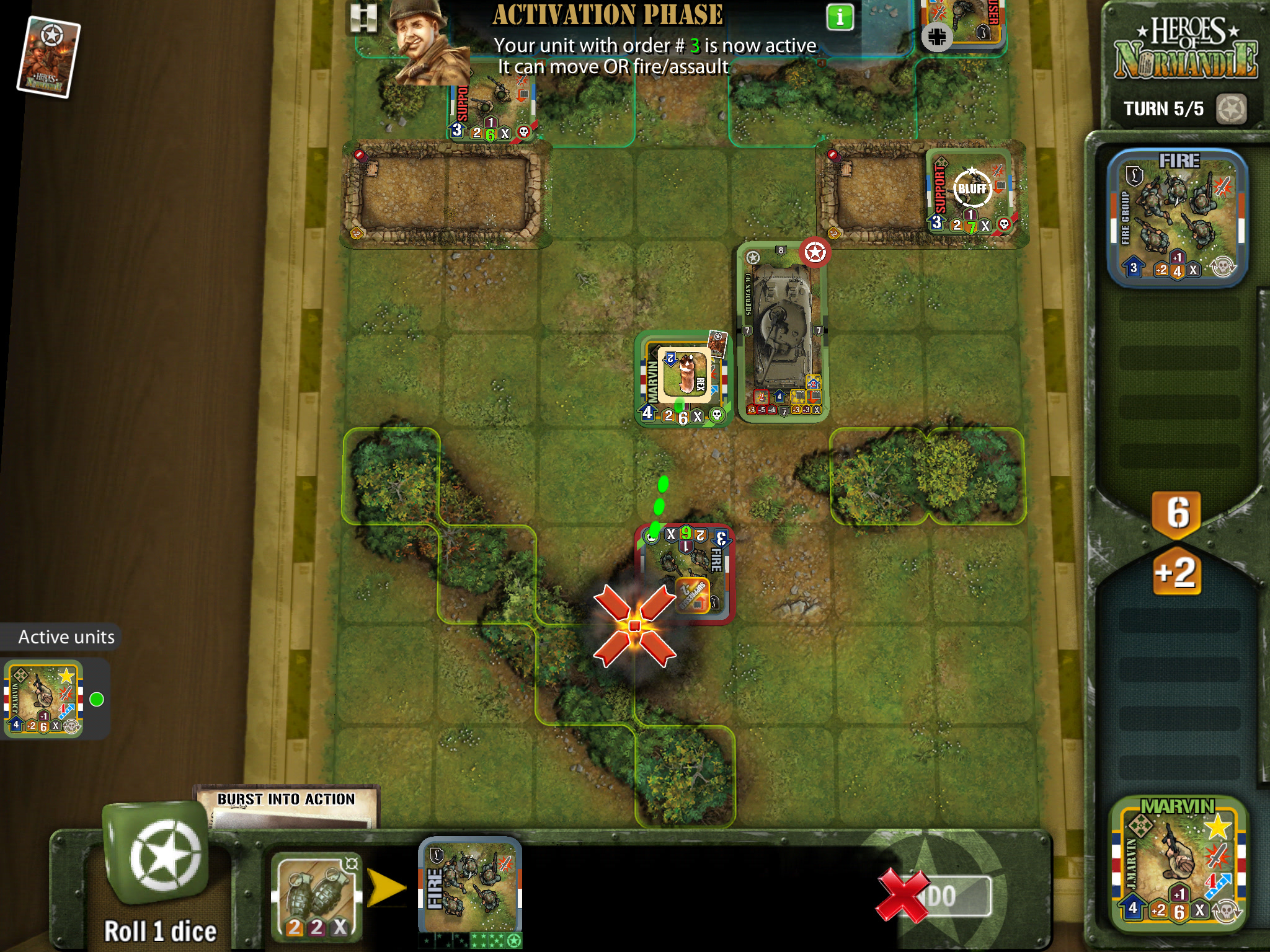 If you’re a fan of strategy games, what is it about them that gets you hooked? Is it the ability to command huge armies and have them engage in long, epic campaigns over huge theaters? Or do you enjoy small, intimate engagements where every unit counts? For me, it’s definitely the latter, and that’s because I like when games tell stories, when my soldiers’ actions weave lovely—or painful—narratives that I can then recount and laugh, or cry. Heroes of Normandie ($14.99), the digital port of the Devil Pig Games’ board game with the same name, is precisely the kind of wargame that creates stories not only because it usually has you command a very small number of units over a pretty small battlefield, but also because the game is constantly celebrating its inspiration: the classic, bombastic WWII movies like The Dirty Dozen and A Bridge Too Far.
If you’re a fan of strategy games, what is it about them that gets you hooked? Is it the ability to command huge armies and have them engage in long, epic campaigns over huge theaters? Or do you enjoy small, intimate engagements where every unit counts? For me, it’s definitely the latter, and that’s because I like when games tell stories, when my soldiers’ actions weave lovely—or painful—narratives that I can then recount and laugh, or cry. Heroes of Normandie ($14.99), the digital port of the Devil Pig Games’ board game with the same name, is precisely the kind of wargame that creates stories not only because it usually has you command a very small number of units over a pretty small battlefield, but also because the game is constantly celebrating its inspiration: the classic, bombastic WWII movies like The Dirty Dozen and A Bridge Too Far.
This inspiration isn’t limited to the types of scenarios and selection of units but, more importantly, also shines in the inclusion of hero units whose names will ring more than a few bells if you’ve watched those old war movies. There are even silly units like cows – which can launch grenades – and dogs – great for carrying documents around – which give Heroes of Normandie a comedic air while at the same time making for great stories. Heroes of Normandie stands as one of the best board game ports on the App Store, and its gameplay rules and abundance of content, and the prospect of additional units and scenarios in the near future, offer hours of tactical fun and make it probably my favorite iOS strategy game.
Heroes of Normandie is at its core a pretty basic squad-based tactical game where you play as the U.S., the Nazi, or the Commonwealth forces. The battles are played on relatively-small maps, and you usually command less than a dozen units at a time. Those units range from your basic infantry to machine guns, mortars, anti-armor, recon and fire teams, as well as different kinds of vehicles and armor. Each unit has a movement range, defense value, attack values against infantry, vehicles, and tanks, as well as other special abilities like assaulting, ambushing, the ability to suppress the opponent, and so on. All the abilities are pretty self-explanatory and the pretty good tutorial campaign helped me figure out pretty much all the intricacies of the game’s mechanics outside things like zones of control. Fortunately, the game has a rule book that supplements the tutorial.
The game’s Order system is where you start getting more opportunities to strategize and surprise your opponent. Each turn you have a specific number of orders along with a bluff token, and you have to assign those orders to your units in the order you want them activated. More often than not, and especially at the beginning of a scenario, you’ll have more units than orders and will have to make painful decisions. You and the opponent can see what units have orders on them but you can’t know the order of activation nor which unit got the bluff order. So, as you can imagine, you’ll have to try and figure out your opponent’s way of thinking and try to counter his or her orders with yours.
Once your unit gets activated, you can either move/assault (assault is when you go in for a melee attack, up close and personal) or attack. Some units can both move and attack on the same turn, but usually there’s a penalty on the attack. You’ll often have to choose which weapon your unit or vehicle should use and whether to go for damaging a unit or suppressing it. If you choose to suppress a unit, your unit’s firing combat value doubles but you do no damage; rather, the unit that’s attacked gets a penalty in movement and firing for the rest of the turn. So, as you can tell, you often have to decide whether to go for the safer option and suppress or risk it and go for damage. Once all the units with orders are activated, there’s the Supply phase where all units that didn’t activate during the Order phase can move.
The other major feature, which has been recently added to the game and has really improved its tactical depth, is Action Cards. There are 29 cards for Germany and 32 for the US, and they can be played either before or during a turn. You have 4 cards in your hand, and you can discard one or more in hopes of getting better ones. These cards can do things like give a unit better odds at taking out an opponent, allow an infantry unit to move and then attack with no penalty, remove the Order marker from an opponent’s unit, allow a unit to enter a building through the window, repair a vehicle, and much more.
In a way, these cards make the game feel more unpredictable and more fun because instead of always knowing that the results of your and your opponent’s actions depend solely on dice, you’ll often be surprised as you watch your plans go awry. There was this one time where my mission was to steal some documents and take them to the edge of the map. So, when I realized I had one unit that could grab them, I saved 2 cards that gave me extra mobility and removed a suppression marker and used them to have that unit sprint away and win me the mission.
In addition to those Action Cards, which can really tip the balance if used properly, Heroes of Normandie also includes Hero units, both infantry and armor ones, that really give the game personality. There’s Clint (no last name but I think it’s safe to say it’s meant to be Clint Eastwood), Marvin, and many other powerful units that while they aren’t too overpowered, they do have good stats and abilities that make them stand out. Some will give you an extra order as long as they’re alive, others can do extra damage to tanks, Ludwig the sniper can take out units in a single shot, and so on. Even though technically you could have removed the names from these units and just have them be special forces or something along those lines, the fact that you do have this over-the-top personalities in the game really helps make Heroes of Normandie more memorable than your average strategy game, and it’s an aspect I really enjoy.
Due to the size of most maps in the game, there’s usually at most one turn before combat ensues, and that makes for a fun, frantic game that plays well on mobile. Instead of spending multiple turns planning and preparing, in Heroes of Normandie you are neck deep in warfare almost from the get-go. It’s funny if you think about the fact that a board game port has the kind of gameplay speed that works well on the “fastest" of all the platforms, mobile. The almost-immediate combat along with the relatively-short number of units also helps make multiplayer encounters easier to deal with because even though they are asynchronous, the fact that you can play your turn in just a few minutes makes it more palatable for those with very busy schedules.
Between the limited units on the battlefield, the Action Cards, the constant action, and the Hero units, Heroes of Normandie ends up being a great engine for fun, or tragic, military stories. There was this one support unit that ended up being the only survivor in this building I had to hold at all costs. The enemy had one Hero unit inside the building and another couple of units approaching. Against all odds, that unit took out all the enemy units one by one, holding on to that building and allowing me to win the scenario. Or that one desperate grenade my injured hero launched from behind a bush – which makes it harder to land it anywhere near your target – that ended up taking both enemy units and opening a path to crossing a river, and many more moments like that.
Because each scenario has a limited number of units and you can’t build more of them along the way – like in games inspired by Advance Wars – each unit counts and each unit can become the hero or the scapegoat (yes, looking at you my lovely tanker who couldn’t hit a German unit if it was looking down your barrel). For instance, there’s a scenario I like playing that has only 4 heroes on each side, which makes playing it feel like a scene from a movie rather than a strategy game.
Also, many of the scenarios aren’t your usual seek & destroy or protect this unit kinds of scenarios; there’s one mission for instance where you have to recover the commander’s dog, Rex, who has stolen the documents you had grabbed in a previous mission and ran into the enemy’s lines. So, now you have to try and take on the Germans while also trying to grab a dog that’s moving around the battlefield. Fun times indeed. The missions also have additional secondary objectives – like eliminating a specific enemy Hero – and achieving those gets you additional gear for the next mission.
Heroes of Normandie also comes with a very good and simple to use map editor that lets you build your own scenarios quite easily. The editor’s interface is pretty intuitive, and in just a few minutes, you can build a scenario with all kinds of objectives. For instance, you can set an area on the map that has to be occupied by the Germans by turn 5 (either anytime during that turn or at the end of the turn), and you can even specify which German unit or units will do the occupying. The editor is very easy to use on the tablet, and even on a phone, and you can then use the maps you create in online multiplayer.
Speaking of the editor and multiplayer, the game offers so much content that you’ll probably never run out of things to do. There are 2 campaigns for each of the three armies, each with 6 missions, a Skirmish mode, which allows you to get a battle going with minimum taps, Custom Missions, where you can play the scenarios you created in the editor, and two “Roguelike Campaigns," one for the German army and one for the US army. The Rogue Mode is challenging but quite fun since you’re given a small budget to recruit your initial army, and then you have to win missions and kill enemies to earn more money, which you can then spend buy more units between missions. And your units carry through the entire campaign, if they survive, so think of this mode as playing with permadeath on. Add to all this content local and online multiplayer modes, and you can see that if you like how Heroes of Normandie plays, you’ll probably never run out of content.
All this content is delivered in a very clear and fun art style that keeps a good balance between realistic and cartoony. The board game art and feel has been ported over very well, and you can zoom in pretty close to check out the action up close and personal. I do wish I could zoom out more though so I could study the whole battlefield in larger maps. The map features are well presented and pleasant, and I didn’t have any issues figuring out what was what. The animations are also great with unit counters lifting off the map and moving or flipping over with exaggerated gravity, which lent a certain sense of tactility to the game. The art and animation are accompanied by pretty good sound effects that help elevate the game even more.
 I left the UI for last because in digital ports of board games, UI decisions can really make or break the digital port. Outside a few relatively-small (but annoying) issues, Heroes of Normandie‘s UI is very well done. All the information needed is right there on the screen, and I was constantly impressed by how effortless playing this game is. And when you need extra information, you can usually find it with one tap. For example, on the Order phase window there’s a button that lets you see the mission objectives, a button that shows you all the cards for your army, a button that explains how those cards work, and a card that shows you all the rules. These 4 buttons barely take any space on the screen but are great help for those still learning the game. The way unit movement and firing is represented on the map is also very intuitive. There are even fun touches, like each army having its own dice, that make playing with the US or the German not only play but also look different.
I left the UI for last because in digital ports of board games, UI decisions can really make or break the digital port. Outside a few relatively-small (but annoying) issues, Heroes of Normandie‘s UI is very well done. All the information needed is right there on the screen, and I was constantly impressed by how effortless playing this game is. And when you need extra information, you can usually find it with one tap. For example, on the Order phase window there’s a button that lets you see the mission objectives, a button that shows you all the cards for your army, a button that explains how those cards work, and a card that shows you all the rules. These 4 buttons barely take any space on the screen but are great help for those still learning the game. The way unit movement and firing is represented on the map is also very intuitive. There are even fun touches, like each army having its own dice, that make playing with the US or the German not only play but also look different.
As I’ve said, though, not everything is rosy when it comes to the UI. Moving a tank around, which requires choosing where the front will face first and then picking the direction of the rear, is not always responsive and when you decide to undo, there’s a rather long animation as the tank moves back to its original position. Yes, the animation is a couple of seconds long, which might not sound like much, but try moving the tank to three or four locations on the same turn and you’ll see how those seconds add up.
Also, when you start moving a tank or another unit, the screen won’t scroll until you finish your move, which means if you were planning on moving a unit beyond what you are currently seeing, you have to put it down, zoom out, and then redo your move. And there are moments when units that use long-range weapons, like a mortar unit, will be shooting outside your current view and you can’t scroll to see whether the shoot is successful or not. While these are relatively-minor things, they are rather annoying because you’ll encounter them often.
Overall, though, Heroes of Normandie is one of my favorite strategy games on the App Store right now, and I’m having a blast playing it. The scenarios are fun, the combat is quick but strategic, and the Action Cards help keep the game unpredictable enough to be entertaining but not too random as to really hurt your tactics. And then there are those stories, those tense moments when you’re hoping that Clint takes down that one unit standing between you and that silly dog, Rex (who by the way won’t be getting a cookie any time soon).
In addition to having loads of content, the game also has some DLC units, like a US Rangers unit (costs $1.99) and an upcoming Panzergenadiers one, and a system that can very easily be expanded with new scenarios and new battles. For example, the physical version has a Shadows over Normandie spin-off that sets Cthulhu against the Allies, and I hope we get that on iOS soon as well. I think it’s easy to tell why I like this game, and if you like strategy games with character and strategy games that play great on mobile despite their board game origins, Heroes of Normandie is definitely for you.








